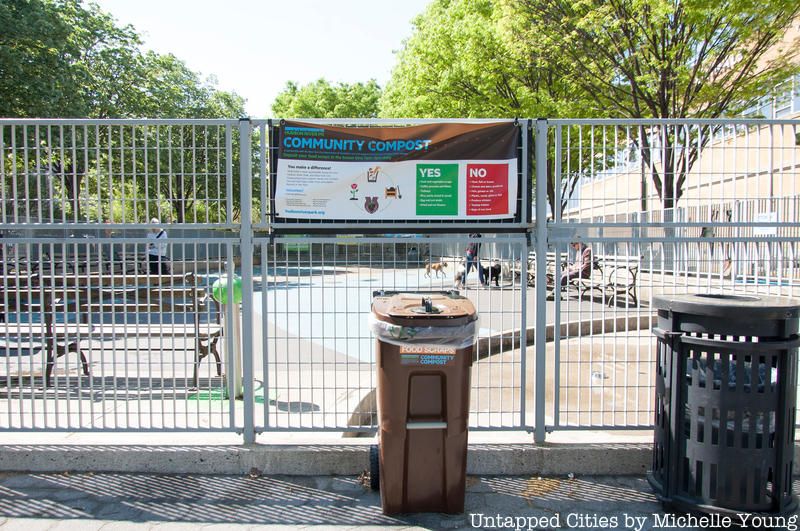Last-Minute NYC Holiday Gift Guide 🎁
We’ve created a holiday gift guide with presents for the intrepid New Yorker that should arrive just in time—



For the past handful of years, four to be exact, strange brown bins have sprouted up next to familiar cobalt blue and spring green public recycling containers. What is it these foreign invaders have come to collect? Your compost — and they’re here to stay.
Composting, or the recycling of organic materials — yard waste such as fall leaves and food sources that were once living, including fruits and vegetables, but not meats — is essentially like any other form of recycling in that it aims to take what was once considered used-up and looks to transform it into something useful once more. Like other recyclables, composting serves more than just the purpose of reducing the amount of landfill waste; composted material is like a super-food for the ground as it helps to naturally improve soil health, which in turn improves the quality of the ingredients New Yorkers consume.
Of course, like all proposed energy-alternatives, composting has faced its fair-share of scrutiny: “How much does composting really help the environment? Is it actually cost effective? Will companies spend more money on labor working to separate the compost-acceptable items than they would if they were to lump them in with the rest of their landfill-bound waste?” “Is risk of smelling my decaying apple cores wafting from that plastic bin on my counter actually worth it?”
These questions would get a chance to be chipped away at when in 2013, the New York City Council passed a law (LL77), which required the NYC Department of Sanitation to implement pilot programs for “voluntary residential organic waste curbside collection” and “school organic waste collection.” The options they provided were bins for individual, at-home composting, and community composting in select areas ranging from 10 to 20,000 sq. feet (mostly located in community gardens). Then in January 2015, DSNY aggregated the statistics from the previous year and complied a pretty complex, yet digestible Community Composting Report.
Here are some of the highlights of what they found:
Since the 2015 report, the DSNY and the rest of the New York City Council has only ramped up their efforts. As of July 2016, businesses, including food vendors and arenas/stadiums that fall under certain size or capacity limits are now required by law to separate their organic waste. As part of his 2018 budget, Governor Cuomo also sent a proposal through the legalization process that if passed would change the limit of those required to participate in recycling their organic food waste to any organization producing two or more tons of food waste a week. Under these stipulations, the law would expand to include organizations and business such as food processors, colleges and universities, hospitals, hotels, and grocery stores among others; it would also require compliance within 4 years.
However, for the time being, the DSNY is choosing to steer its efforts away from the commercial and continue to focus on the residential composting as part of their “Zero Waste” program, which has as its bottom-line goal to “contribute zero waste to landfills by 2030.”
One organization that’s working in partnership with the DSNY is Grow NYC, which as part of it efforts, urges New Yorkers to “make landscape, not landfill.” To help New Yorkers participate in working toward their goals, they’ve provided food collection locations at 60 different spots, and started their newest addition: commuter drop-off locations along with the nifty map below pin-pointing their locations.
Map of organic waste commuter drop-off locations via Grow NYC
As many New Yorkers had expressed at the beginning of DSNY’s composting initiative, thinking about starting the composting process can be daunting. However, just like regular recycling, there are many avenues one can take in order to tailor-make the process for the individual life. Beyond the options of how to go about getting your organic waste from home to composite site (collection or drop-off at commuter sites or community gardens), there are many options for how to go about collecting and containing your waste. DSNY provides a list of options for container equipment complete with the dimensions and other details of each as well as pricing and where you can buy each item. They also offer in-person workshops, or online access to education material as well as a comprehensive list of all places to drop-off your organic material across the five boroughs—again, all located on the DSNY site under the “Zero Waste” tab.
Looking purely at numbers, New York City currently has the largest residential organics collection program in the country, according to the New York Times, which clocks the city in at around one million participants. Of course, with roughly 8.5 million people living within New York City limits (as of 2014) that makes one million residents only 12 percent of the population. However, there are already plans in place for DSNY to expand their operations to more neighborhoods in Brooklyn, the Bronx and Queens. If those plans combined with the upcoming legislation are any indication of where New York City is heading, greater accessibility might not just be possible, but mandatory in the coming years.
For more information on the future of NYC compositing and a closer look at the how the process works, check out our “Cities 101” column: Kathryn Garcia, the NYC Sanitation Commissioner Speaks on the Future of Waste or discover The Top 10 Secrets of NYC’s Department of Sanitation. Get in touch with the author: @Erika_A_Stark
Subscribe to our newsletter